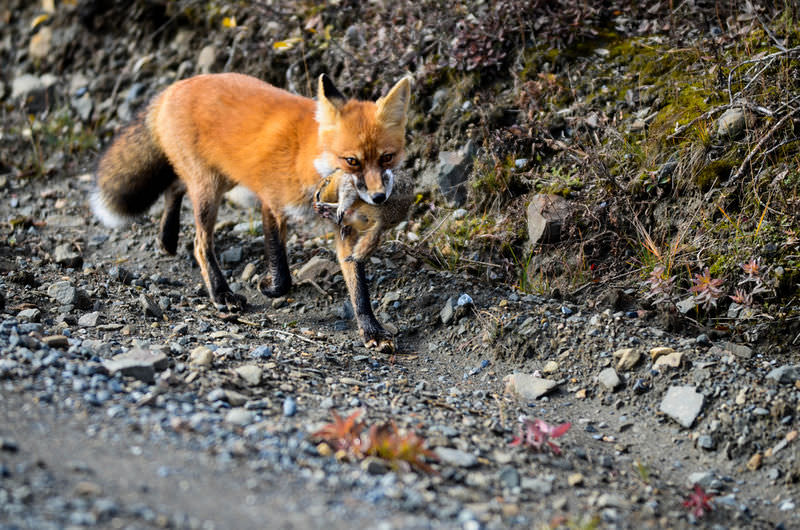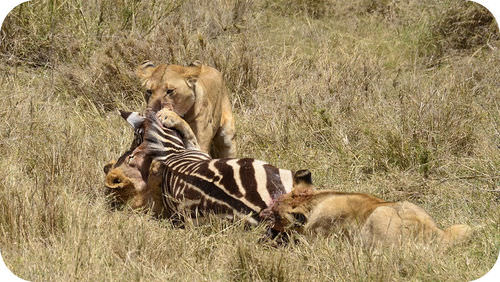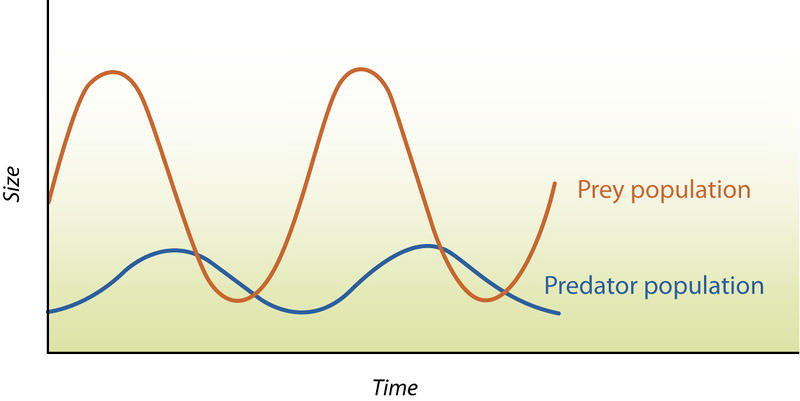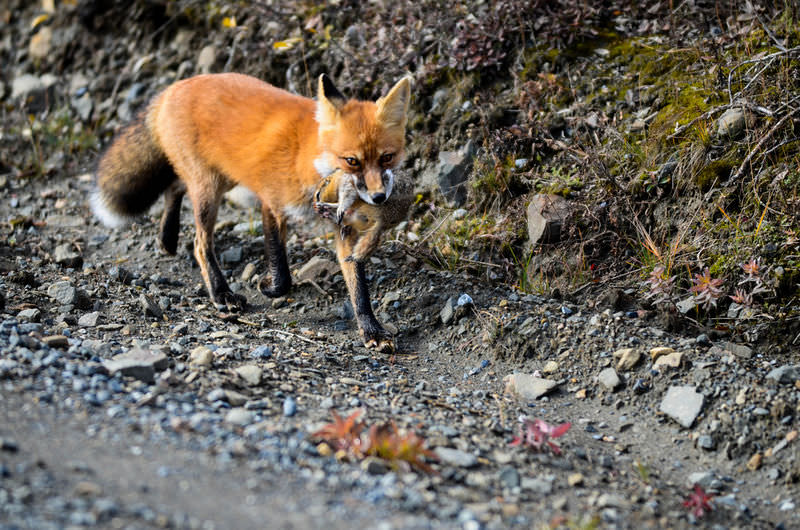6.4: Predation
- Page ID
- 12132
\( \newcommand{\vecs}[1]{\overset { \scriptstyle \rightharpoonup} {\mathbf{#1}} } \)
\( \newcommand{\vecd}[1]{\overset{-\!-\!\rightharpoonup}{\vphantom{a}\smash {#1}}} \)
\( \newcommand{\id}{\mathrm{id}}\) \( \newcommand{\Span}{\mathrm{span}}\)
( \newcommand{\kernel}{\mathrm{null}\,}\) \( \newcommand{\range}{\mathrm{range}\,}\)
\( \newcommand{\RealPart}{\mathrm{Re}}\) \( \newcommand{\ImaginaryPart}{\mathrm{Im}}\)
\( \newcommand{\Argument}{\mathrm{Arg}}\) \( \newcommand{\norm}[1]{\| #1 \|}\)
\( \newcommand{\inner}[2]{\langle #1, #2 \rangle}\)
\( \newcommand{\Span}{\mathrm{span}}\)
\( \newcommand{\id}{\mathrm{id}}\)
\( \newcommand{\Span}{\mathrm{span}}\)
\( \newcommand{\kernel}{\mathrm{null}\,}\)
\( \newcommand{\range}{\mathrm{range}\,}\)
\( \newcommand{\RealPart}{\mathrm{Re}}\)
\( \newcommand{\ImaginaryPart}{\mathrm{Im}}\)
\( \newcommand{\Argument}{\mathrm{Arg}}\)
\( \newcommand{\norm}[1]{\| #1 \|}\)
\( \newcommand{\inner}[2]{\langle #1, #2 \rangle}\)
\( \newcommand{\Span}{\mathrm{span}}\) \( \newcommand{\AA}{\unicode[.8,0]{x212B}}\)
\( \newcommand{\vectorA}[1]{\vec{#1}} % arrow\)
\( \newcommand{\vectorAt}[1]{\vec{\text{#1}}} % arrow\)
\( \newcommand{\vectorB}[1]{\overset { \scriptstyle \rightharpoonup} {\mathbf{#1}} } \)
\( \newcommand{\vectorC}[1]{\textbf{#1}} \)
\( \newcommand{\vectorD}[1]{\overrightarrow{#1}} \)
\( \newcommand{\vectorDt}[1]{\overrightarrow{\text{#1}}} \)
\( \newcommand{\vectE}[1]{\overset{-\!-\!\rightharpoonup}{\vphantom{a}\smash{\mathbf {#1}}}} \)
\( \newcommand{\vecs}[1]{\overset { \scriptstyle \rightharpoonup} {\mathbf{#1}} } \)
\( \newcommand{\vecd}[1]{\overset{-\!-\!\rightharpoonup}{\vphantom{a}\smash {#1}}} \)
\(\newcommand{\avec}{\mathbf a}\) \(\newcommand{\bvec}{\mathbf b}\) \(\newcommand{\cvec}{\mathbf c}\) \(\newcommand{\dvec}{\mathbf d}\) \(\newcommand{\dtil}{\widetilde{\mathbf d}}\) \(\newcommand{\evec}{\mathbf e}\) \(\newcommand{\fvec}{\mathbf f}\) \(\newcommand{\nvec}{\mathbf n}\) \(\newcommand{\pvec}{\mathbf p}\) \(\newcommand{\qvec}{\mathbf q}\) \(\newcommand{\svec}{\mathbf s}\) \(\newcommand{\tvec}{\mathbf t}\) \(\newcommand{\uvec}{\mathbf u}\) \(\newcommand{\vvec}{\mathbf v}\) \(\newcommand{\wvec}{\mathbf w}\) \(\newcommand{\xvec}{\mathbf x}\) \(\newcommand{\yvec}{\mathbf y}\) \(\newcommand{\zvec}{\mathbf z}\) \(\newcommand{\rvec}{\mathbf r}\) \(\newcommand{\mvec}{\mathbf m}\) \(\newcommand{\zerovec}{\mathbf 0}\) \(\newcommand{\onevec}{\mathbf 1}\) \(\newcommand{\real}{\mathbb R}\) \(\newcommand{\twovec}[2]{\left[\begin{array}{r}#1 \\ #2 \end{array}\right]}\) \(\newcommand{\ctwovec}[2]{\left[\begin{array}{c}#1 \\ #2 \end{array}\right]}\) \(\newcommand{\threevec}[3]{\left[\begin{array}{r}#1 \\ #2 \\ #3 \end{array}\right]}\) \(\newcommand{\cthreevec}[3]{\left[\begin{array}{c}#1 \\ #2 \\ #3 \end{array}\right]}\) \(\newcommand{\fourvec}[4]{\left[\begin{array}{r}#1 \\ #2 \\ #3 \\ #4 \end{array}\right]}\) \(\newcommand{\cfourvec}[4]{\left[\begin{array}{c}#1 \\ #2 \\ #3 \\ #4 \end{array}\right]}\) \(\newcommand{\fivevec}[5]{\left[\begin{array}{r}#1 \\ #2 \\ #3 \\ #4 \\ #5 \\ \end{array}\right]}\) \(\newcommand{\cfivevec}[5]{\left[\begin{array}{c}#1 \\ #2 \\ #3 \\ #4 \\ #5 \\ \end{array}\right]}\) \(\newcommand{\mattwo}[4]{\left[\begin{array}{rr}#1 \amp #2 \\ #3 \amp #4 \\ \end{array}\right]}\) \(\newcommand{\laspan}[1]{\text{Span}\{#1\}}\) \(\newcommand{\bcal}{\cal B}\) \(\newcommand{\ccal}{\cal C}\) \(\newcommand{\scal}{\cal S}\) \(\newcommand{\wcal}{\cal W}\) \(\newcommand{\ecal}{\cal E}\) \(\newcommand{\coords}[2]{\left\{#1\right\}_{#2}}\) \(\newcommand{\gray}[1]{\color{gray}{#1}}\) \(\newcommand{\lgray}[1]{\color{lightgray}{#1}}\) \(\newcommand{\rank}{\operatorname{rank}}\) \(\newcommand{\row}{\text{Row}}\) \(\newcommand{\col}{\text{Col}}\) \(\renewcommand{\row}{\text{Row}}\) \(\newcommand{\nul}{\text{Nul}}\) \(\newcommand{\var}{\text{Var}}\) \(\newcommand{\corr}{\text{corr}}\) \(\newcommand{\len}[1]{\left|#1\right|}\) \(\newcommand{\bbar}{\overline{\bvec}}\) \(\newcommand{\bhat}{\widehat{\bvec}}\) \(\newcommand{\bperp}{\bvec^\perp}\) \(\newcommand{\xhat}{\widehat{\xvec}}\) \(\newcommand{\vhat}{\widehat{\vvec}}\) \(\newcommand{\uhat}{\widehat{\uvec}}\) \(\newcommand{\what}{\widehat{\wvec}}\) \(\newcommand{\Sighat}{\widehat{\Sigma}}\) \(\newcommand{\lt}{<}\) \(\newcommand{\gt}{>}\) \(\newcommand{\amp}{&}\) \(\definecolor{fillinmathshade}{gray}{0.9}\)
What may be the most common way different species interact?
Biomes as different as deserts and wetlands share something very important. All biomes have populations of interacting species. Species interact in the same basic ways in all biomes. For example, all biomes have some species that prey on others for food.
Predation
Predation is a relationship in which members of one species (the predator) consume members of another species (the prey). The lionesses and zebra in Figure below are classic examples of predators and prey. In addition to the lionesses, there is another predator in this figure. Can you spot it? The other predator is the zebra. Like the lionesses, it consumes prey species, in this case species of grass. However, unlike the lionesses, the zebra does not kill its prey. Predator-prey relationships such as these account for most energy transfers in food chains and food webs.

Predators and Their Prey. These lionesses feed on the carcass of a zebra.
Predation and Population
A predator-prey relationship tends to keep the populations of both species in balance. This is shown by the graph in Figure below. As the prey population increases, there is more food for predators. So, after a slight lag, the predator population increases as well. As the number of predators increases, more prey are captured. As a result, the prey population starts to decrease. What happens to the predator population then?
 Predator-Prey Population Dynamics. As the prey population increases, why does the predator population also increase?
Predator-Prey Population Dynamics. As the prey population increases, why does the predator population also increase?In the predator-prey example, one factor limits the growth of the other factor. As the prey population deceases, the predator population begins to decrease as well. The prey population is a limiting factor. A limiting factor limits the growth or development of an organism, population, or process.
Keystone Species
Some predator species are known as keystone species. A keystone species is one that plays an especially important role in its community. Major changes in the numbers of a keystone species affect the populations of many other species in the community. For example, some sea star species are keystone species in coral reef communities. The sea stars prey on mussels and sea urchins, which have no other natural predators. If sea stars were removed from a coral reef community, mussel and sea urchin populations would have explosive growth. This, in turn, would drive out most other species. In the end, the coral reef community would be destroyed.
Adaptations to Predation
Both predators and prey have adaptations to predation that evolve through natural selection. Predator adaptations help them capture prey. Prey adaptations help them avoid predators. A common adaptation in both predator and prey is camouflage. Several examples are shown in Figure below. Camouflage in prey helps them hide from predators. Camouflage in predators helps them sneak up on prey.
 Camouflage in Predator and Prey Species. Can you see the crab in the photo on the left? It is camouflaged with the sand. The preying mantis in the middle photo looks just like the dead leaves in the background. Can you tell where one zebra ends and another one begins? This may confuse a predator and give the zebras a chance to run away.
Camouflage in Predator and Prey Species. Can you see the crab in the photo on the left? It is camouflaged with the sand. The preying mantis in the middle photo looks just like the dead leaves in the background. Can you tell where one zebra ends and another one begins? This may confuse a predator and give the zebras a chance to run away.Science Friday: Can Underwater Parks Protect Coral?
Coral communities are incredibly important for marine life. In this video by Science Friday, Marine scientists John Bruno and Elizabeth Selig describe the effects of local Marine Protection Areas on preserving coral.
Summary
- Predation is a relationship in which members of one species (the predator) consume members of another species (the prey).
- A predator-prey relationship keeps the populations of both species in balance.
Review
- Describe the relationship between a predator population and the population of its prey.
- What is a keystone species? Give an example.
- What is a limiting factor?
- What is the role of camouflage in prey and predator?
| Image | Reference | Attributions |
 |
[Figure 1] | Credit: Crab: Thomas Hubauer; Mantis: Adrian Pingstone; Zebra: Paul Maritz, edited by User:Pharaoh Hound/Wikimedia Commons and User:Fir0002/Wikimedia Commons;Viceroy: James D Rucker; Monarch: William Warby (Flickr:wwarby) Source: Crab: http://www.flickr.com/photos/drth80/8754597558/ ; Mantis: commons.wikimedia.org/wiki/File:Bristol.zoo.dead.leaf.mantis.arp.jpg ; Zebra: commons.wikimedia.org/wiki/File:Zebra_Botswana_edit02.jpg ; Viceroy: http://www.flickr.com/photos/25183035@N03/7438612588/ ; Monarch: http://www.flickr.com/photos/wwarby/8190412331/ License: Crab: CC BY 2.0; Mantis: Public Domain; Zebra: CC BY 2.5 |
 |
[Figure 2] | Credit: Patti Sandoval;(a) Jan Tik; (b) Flickr:qorize; (c) Courtesy of Prof. Gordon T. Taylor, Stony Brook University/NSF Polar Programs Source: http://www.flickr.com/photos/thomson-safaris/8377408989/ License: CC BY 2.0 |
 |
[Figure 3] | Credit: Hana Zavadska Source: CK-12 Foundation License: CC BY-NC 3.0 |
 |
[Figure 4] | Credit: Crab: Thomas Hubauer; Mantis: Adrian Pingstone; Zebra: Paul Maritz, edited by User:Pharaoh Hound/Wikimedia Commons and User:Fir0002/Wikimedia Commons Source: Crab: http://www.flickr.com/photos/drth80/8754597558/ ; Mantis: commons.wikimedia.org/wiki/File:Bristol.zoo.dead.leaf.mantis.arp.jpg ; Zebra: commons.wikimedia.org/wiki/File:Zebra_Botswana_edit02.jpg License: Crab: CC BY 2.0; Mantis: Public Domain; Zebra: CC BY 2.5 |

